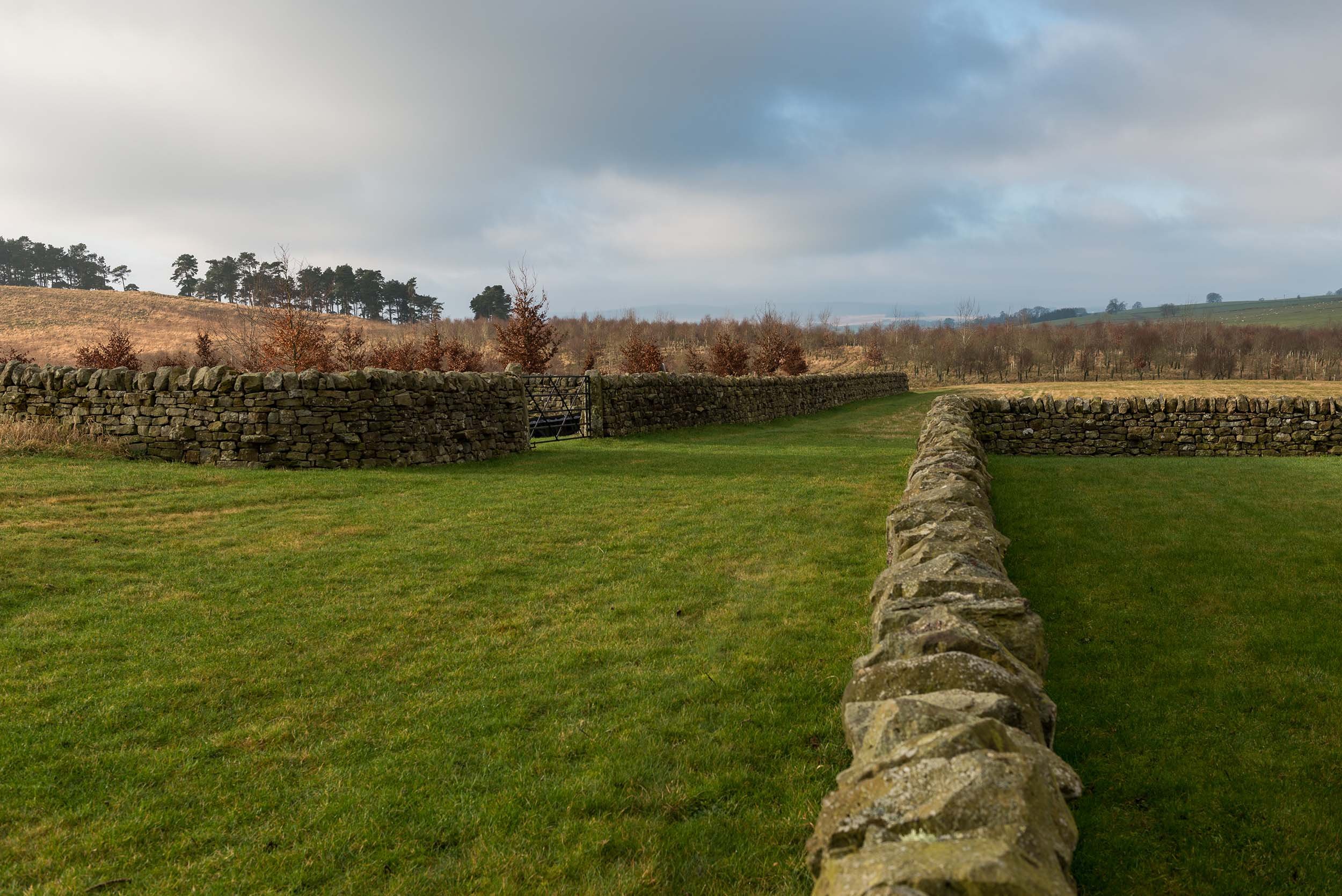The Haining
I first met Tessa and Paul at a rather wet and windy Alwinton Show. They came to my stand, spent some time and bought a calendar. I must admit I didn’t think a great deal about it, it’s always a busy day. Just after the show, Tessa got in touch and we soon met again over coffee and biscuits at The Haining. We discussed a project they hoped I’d be interested in, to photograph and document The Haining over the coming year.
After a tour of the beautiful 17th century farmhouse, we headed out into a bright sunny winter’s morning and walked into the woodland. Tessa and Paul were both warm, generous and justifiably proud. Their enthusiasm and love of the landscape was palpable, I listened as they talked about The Haining project and their vision for its development and future. Their inspiration became the basis for many of the photographs I would take.
I initially wanted to get a broad overview of The Haining, its place in the landscape and relationship to the surrounding area. Parking at nearby Elsdon, I took the old drovers road to the Otterburn Ranges and cut down at Fairneycleugh to the Elsdon Burn from the north, as many have before me, the area has a turbulent past. I began to take photographs, it’s always good to make a start and ease myself into a project. I continued to take photographs as I headed across the valley and up to Gallow Hill. For my next visit, I parked up at a handy lay-by beside Elsdon Bridge. I crossed the field beside the burn, past the house, then up and onto the western boundary. There’s a hillfort or an ancient enclosure here. As Haining often means enclosure, I wondered if that’s where the name came from.
Once I’d been up, down and around, I would visit every month. My usual way of working tends to be in a smallish area, I often carve up the vast landscape into bite sized or walkable chunks. I do like a destination and always aware of safety, I’m on my own in the landscape, others know where I am. On occasion, I’ll take a photograph that can set me up for the day, sometimes longer, but I usually have to work an area. I’ll walk and just look, take sketch shots, visualise ideas and compositions. Once I’m happy with the work I’ve produced, I tend to move on, work continues elsewhere. My main challenge was to continue this work over a year and to document this landscape, the change in seasons would surprise and inspire. I usually planned my visits, but I would often call in when passing by, it was always somewhere nice and peaceful to go. I would vary the times I visited, from early morning to late evening and I might spend an hour or two, or be there for the day. If something happened, when it snowed, some great light, or the beautiful fresh green of new leaves (much anticipated) I’d be there with my camera.
As the tired green leaves and bleached grasses led their way into autumn, I would soon be back at Alwinton Show. It would be a beautiful sunny and even busier day, my new Northumberland calendar would be on my stand. The time I would spend at The Haining was almost over, I would only make two more visits. One visit would take me back to the hillfort and I could see the old field systems in the late evening sun, centuries of agriculture had changed a once forested landscape. The new woodland here contrasted with the evergreen fir and spruce copses, dotted about, windbreaks in the valley. I can only hope for more woodlands like this, wildlife thrives here. It only takes a bit of imagination, drive and collaboration, especially with those that love, live and work the landscape. I walked past the house as I left, it was at the heart of the landscape, all paths led there and it could easily draw the eye. I turned round and took my last photograph, it was always hard to resist.
I would send a batch of photos every month and we’d exchange emails throughout. We’d discuss idea’s and photos, what was happening in the landscape, local news and even the weather, especially when there was some serious flooding during August. When they were both at The Haining, I would visit, it was always good to see them and walk the landscape again. It all turned out to be a very collaborative, fulfilling and enjoyable project. The photographs chosen by Tessa and Paul, 13 including the cover, were apparently very difficult to make, which in a way I was rather pleased about. It includes the very first photograph taken on the project and I was also very pleased with the cover shot. Paul loved the walls and I’d already taken numerous photographs. A beautiful summer’s morning was all I needed, feeling relaxed and peaceful, the photo was almost effortless. I used my own existing template to produce the Nortumbrian Woodland calendar and organised the sustainable printing and delivery. Just over a hundred copies were made and these were given to friends, family and those in the local community, I still have mine. The images are all below and I’ve added all the text by Tessa from the rear cover, just updating my website address. All photographs were taken between 16th November 2018 and 23rd October 2019.
Northumbrian Woodland 2020 - Calendar Cover
Northumbrian Woodland 2020 - January
Northumbrian Woodland 2020 - February
Northumbrian Woodland 2020 - March
Northumbrian Woodland 2020 - April
Northumbrian Woodland 2020 - May
Northumbrian Woodland 2020 - June
Northumbrian Woodland 2020 - July
Northumbrian Woodland 2020 - August
Northumbrian Woodland 2020 - September
Northumbrian Woodland 2020 - October
Northumbrian Woodland 2020 - November
Northumbrian Woodland 2020 - December
Northumbrian Woodland
People assume that if you plant a forest you will never see it in your lifetime - that’s not true. During the winter of 2007/2008, we began planting a forest. It has been the most amazing experience and adventure that we have been on. Each sapling started off with a stake and a tree guard to protect it from deer, vole and hare. The trees have needed constant repair and support, sometimes simply due to the exposed nature of the land. Putting the right tree in the right place, so that it is happy with its conditions, is paramount.
We have been planting continually most years since that first winter, and now have a wood of over 100,000 mixed broadleaf trees. The early transition is the most rewarding: creating a diverse habitat for wildlife. Nature reclaims the land so fast. Some trees are already over 5 metres high with trunks like lamp posts whilst others languish at shoulder height.
Ponds were created by just digging away the earth and are now home to a multitude of creatures.
This is a visual record of a year on the land, and was very kindly photographed by Martin Ellis. To view more of his work: martinjaellis.com
Planting list:
Alder, Ash, Aspen, Beech, Bird Cherry, Blackthorn, Douglas Fir, Downy Birch, Elder, English Oak, European Larch, Field Maple, Giant Redwood, Goat Willow, Grey Willow, Hawthorn, Hazel, Holy, Hornbeam, Juniper, Norway Maple, Norway Spruce, Red Oak, Rowan, Scotts Pine, Silver Birch, Silver Willow, Sitka Spruce, Small Leaved Lime, Swedish Whitebeam, Sycamore, Whitebeam, White Poplar and White Willow.
Thank you from Tessa and Paul
William Massey from Trees Please for all his extraordinary planting, advice and commitment, Mike Bell for invaluable guidance, Dr Ian Roberts for his help in getting us started, Neil Dixon formerly of the Forestry Commission, David Scott who builds the best Northumbrian walls, Davey Renton for his constance, Alan and Andrew Dodd for all their help
The Haining
The house as was, a ruin and almost at the point of collapse. This image was supplied to me by Tessa. I converted it to black & white and included it on the rear of the calendar.
A Few More
A Return
After a few years, I decided it was time to walk The Haining again. I followed the route of my first visit and as soon as I headed down, I felt drawn to those first photographs. It only felt like weeks since I’d last visited, but much had happened since. This time I brought a medium format camera with some black and white film. The house was shuttered with no signs of activity, which was nothing new, but this time it somehow felt different. I later learned that The Haining had been generously gifted to the Northumberland Wildlife Trust and the house has now been converted into a holiday let.
Out of the photographs I took on my return, I found I was happiest with the ones taken on the way. There’s so much in Redesdale to explore and so in the future, The Haining will become part of my journey, as it already has.
If you want to find out more about The Haining and perhaps book a holiday, please click here, it already seems rather popular. You never know, you may see me wandering past and checking on the trees.



































